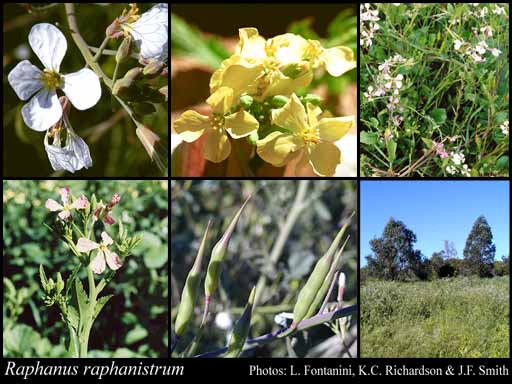- Reference
- Sp.Pl. [Linnaeus] 2:669 (1753)
- Conservation Code
- Not threatened
- Naturalised Status
- Alien to Western Australia
- Name Status
- Current
Erect annual, herb, 0.15-1 m high. Fl. yellow-white/pink, Apr to May or Jul to Nov. Disturbed areas.

Distribution
- IBRA Regions
- Avon Wheatbelt, Carnarvon, Dampierland, Esperance Plains, Geraldton Sandplains, Jarrah Forest, Mallee, Swan Coastal Plain, Victoria Bonaparte, Warren, Yalgoo.
- IBRA Subregions
- Cape Range, Eastern Mallee, Edel, Fitzgerald, Geraldton Hills, Katanning, Keep, Lesueur Sandplain, Merredin, Northern Jarrah Forest, Perth, Pindanland, Recherche, Southern Jarrah Forest, Tallering, Warren, Western Mallee, Wooramel.
- IMCRA Regions
- Abrolhos Islands, Central West Coast, Leeuwin-Naturaliste, WA South Coast.
- Local Government Areas (LGAs)
- Albany, Armadale, Augusta Margaret River, Bayswater, Bridgetown-Greenbushes, Broome, Broomehill-Tambellup, Busselton, Carnarvon, Chapman Valley, Chittering, Cockburn, Coorow, Cottesloe, Cranbrook, Dalwallinu, Dandaragan, Dardanup, Donnybrook-Balingup, Dumbleyung, Esperance, Exmouth, Gingin, Gnowangerup, Goomalling, Gosnells, Greater Geraldton, Harvey, Kalamunda, Katanning, Lake Grace, Manjimup, Melville, Merredin, Mingenew, Mundaring, Murray, Northam, Northampton, Perth, Pingelly, Quairading, Ravensthorpe, Rockingham, Serpentine-Jarrahdale, Shark Bay, Stirling, Swan, Vincent, Wagin, Wandering, Wanneroo, Wongan-Ballidu, Wyalkatchem, Wyndham-East Kimberley, Yalgoo.
Management Notes (for the Swan NRM Region)
Alternative Names. Jointed Charlock, Mediterranean Radish, Sea Radish.
General Biology. Growth form. Herb. Life form. Annual. Reproduction. Seed. Dispersal. Wind, water, machinery. Toxicity. Poisonous in large quantities to mammals. Seedbank persistence. 20 years.
Notes. Can be biennial. Weed of highly disturbed edges. Germinates after significant autumn rains, otherwise germination can be sporadic and staggered throughout the year. Has a flexible lifecycle, high genotypic and phenotypic variablity, enabling it to adapt to different environments. Produces prolific seed with high longevity and dormancy. Has recorded resistance to chlorsulfuron in South Africa and multiple resistance to several herbicide groups in other regions.
Additional information. History of use/introduction. Macaronesia, northern Africa, temperate Asia, Europe.
Suggested method of management and control. Hand remove isolated plants several times throughout the year. Spot spray 1% glyphosate before flowering. A combination of approaches is usually most successful. Read the manufacturers' labels and material safety data sheets before using herbicides. For further information consult the Australian Pesticides and Veterinary Medicines Authority to determine the status of permits for your situation or state.
Management Calendar
| Calendar Type | Jan | Feb | Mar | Apr | May | Jun | Jul | Aug | Sep | Oct | Nov | Dec | Comments |
|---|---|---|---|---|---|---|---|---|---|---|---|---|---|
| Germination | O | O | O | Y | Y | Y | Y | Y | Y | O | O | O | |
| Active Growth | Y | Y | Y | Y | Y | Y | Y | Y | Y | Y | Y | Y | |
| Flowering | Y | Y | Y | Y | Y | Y | Y | Y | |||||
| Fruiting | Y | Y | Y | Y | Y | Y | Y | ||||||
| Manual Removal | O | O | O | O | O | Y | Y | Y | Y | Y | Y | Y | |
| Herbicide Treatment | O | O | O | O | O | O | O | O | O | O | O | O |
Legend: Y = Yes, regularly, O = Occasionally, U = Uncertain, referred by others but not confirmed.
References
- Ali Bhatti, M. (2004) Genetic variation in naturalized wild radish (Raphanus raphanistrum L.) populations in the mediterranean climate of south-western Australia. University of WA, Perth. Thesis.
- Brown, K. & Brooks, K. (2002) Bushland Weeds: A Practical Guide to their Management. Environmental Weeds Action Network, Greenwood.
- Campbell, B. (2004) Best management practice for wild radish control. In Geraldton Crop Update, 5 Mar 2004, Geraldton WA, Proceedings. Western Australian Department of Agriculture, s.l., 2004, p52-53.
- Cheam, A.C. & Code, G.R. (1998) Raphanus raphanistrum L. In The Biology of Australian Weeds Vol. 2 (eds. F.D. Panetta, R.H. Groves, & R.C.H. Shepherd). R.G. & F.J. Richardson, Melbourne.
- Eslami, S.V. (2006) Ecology of wild radish (Raphanus raphanistrum) crop-weed competition and seed dormancy. University of Adelaide, South Australia. Thesis.
- Hussey, B.M.J., Keighery, G.J., Dodd, J., Lloyd, S.G. & Cousens, R.D. (2007) Western Weeds. A guide to the weeds of Western Australia. 2nd Edition. The Plant Protection Society of Western Australia, Victoria Park.
- Malik, M.S., Norsworthy, J.K., Riley, M.B. & Bridges, W. (2010) Temperature and light requirements for wild radish (Raphanus raphanistrum) germination over a 12-month period following maturation. Weed Science, 58 (2): 136–140.
- Moore, J.H. & Wheeler, J. (2008) Southern weeds and their control. DAFWA Bulletin 4744.
- Parsons, W.T. & Cuthbertson, E.G. (2001) Noxious weeds of Australia. 2nd Edition. CSIRO Publishing, Collingwood.
- Smit, J.J. & Carins, A.L.P. (2001) Resistance of Raphanus raphanistrum to chlorsulfuron in the Republic of South Africa. Weed Research, 41 (1): 41-47.
- USDA, ARS, National Genetic Resources Program (2009) Germplasm Resources Information Network - (GRIN). National Germplasm Resources Laboratory, Beltsville, Maryland. URL: https://npgsweb.ars-grin.gov/gringlobal/taxon/taxonomysimple.aspx - Accessed October 2009.
- Young, K. & Cousens, R. (1999) Factors affecting the germination and emergence of wild radish (Raphanus raphanistrum) and their effect on management options. In 12th Australian Weeds Conference - weed management into the 21st Century: do we know where we're going? (Eds) A.C Bishop, M. Boersma, and C.D. Barnes, Hobart 12-16 September 1999. Tasmanian Weed Society Inc.